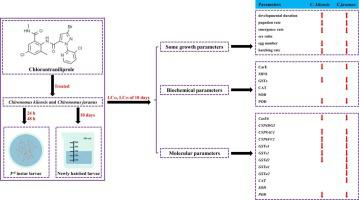农药残留对水稻生态系统具有严重的环境影响。在稻田中,摇蚊和爪哇摇蚊为水稻害虫的捕食性天敌提供了替代食物来源,尤其是在害虫数量较少的情况下。氯虫苯甲酰胺是老一类杀虫剂的替代品,已广泛用于防治水稻害虫。为了确定氯虫苯甲酰胺在稻田中的生态风险,我们评估了它对这两种摇蚊的某些生长、生化和分子参数的毒性作用。通过将三龄幼虫暴露于一系列浓度的氯虫苯甲酰胺来进行毒性测试。LC 5024 小时、48 小时和 10 天的值表明,氯虫苯甲酰胺对爪哇爪哇甲虫的毒性高于金氏甲虫。氯虫苯甲酰胺在亚致死剂量下显着延长了幼虫的生长持续时间,抑制了化蛹和羽化,并减少了C. kiiensis和C. javanus的卵数(对于C. kiiensis ,LC 10 = 1.50 mg/L 和 LC 25 = 3.00 mg/L ;LC C. javanus 10 = 0.25 mg/L 和 LC 25 = 0.50 mg/L )。亚致死暴露于氯虫苯甲酰胺会显着降低解毒酶羧酸酯酶 (CarE) 和谷胱甘肽S的活性-C. kiiensis和C. javanus中的转移酶 (GST) 。亚致死性暴露于氯虫苯甲酰胺还显着抑制了C. kiiensis中抗氧化酶过氧化物酶 (POD) 的活性以及C. javanus中的 POD 和过氧化氢酶 (CAT) 。12 个基因的表达水平表明解毒和抗氧化能力受到氯虫苯甲酰胺亚致死暴露的影响。7个基因( CarE6、CYP9AU1、CYP6FV2、GSTo1、GSTs1、GSTd2、POD)在金丝雀中的表达水平发生了显着变化。C. javanus中的10个基因(CarE6、CYP9AU1、CYP6FV2、GSTo1、GSTs1、GSTd2、GSTu1、GSTu2、CAT和POD)。这些结果全面概述了氯虫苯甲酰胺对摇蚊的毒性差异,表明爪哇螟更易感,更适合作为水稻生态系统生态风险评估的指标。
 "点击查看英文标题和摘要"
"点击查看英文标题和摘要"
Sublethal effects of chlorantraniliprole on growth, biochemical and molecular parameters in two chironomids, Chironomus kiiensis and Chironomus javanus
Pesticide residues have serious environmental impacts on rice-based ecosystems. In rice fields, Chironomus kiiensis and Chironomus javanus provide alternative food sources to predatory natural enemies of rice insect pests, especially when pests are low. Chlorantraniliprole is a substitute for older classes of insecticides and has been used extensively to control rice pests. To determine the ecological risks of chlorantraniliprole in rice fields, we evaluated its toxic effects on certain growth, biochemical and molecular parameters in these two chironomids. The toxicity tests were performed by exposing third-instar larvae to a range of concentrations of chlorantraniliprole. LC50 values at 24 h, 48 h, and 10 days showed that chlorantraniliprole was more toxic to C. javanus than to C. kiiensis. Chlorantraniliprole significantly prolonged the larval growth duration, inhibited pupation and emergence, and decreased egg numbers of C. kiiensis and C. javanus at sublethal dosages (LC10 = 1.50 mg/L and LC25 = 3.00 mg/L for C. kiiensis; LC10 = 0.25 mg/L and LC25 = 0.50 mg/L for C. javanus). Sublethal exposure to chlorantraniliprole significantly decreased the activity of the detoxification enzymes carboxylesterase (CarE) and glutathione S-transferases (GSTs) in both C. kiiensis and C. javanus. Sublethal exposure to chlorantraniliprole also markedly inhibited the activity of the antioxidant enzyme peroxidase (POD) in C. kiiensis and POD and catalase (CAT) in C. javanus. Expression levels of 12 genes revealed that detoxification and antioxidant abilities were affected by sublethal exposures to chlorantraniliprole. There were significant changes in the expression levels of seven genes (CarE6, CYP9AU1, CYP6FV2, GSTo1, GSTs1, GSTd2, and POD) in C. kiiensis and ten genes (CarE6, CYP9AU1, CYP6FV2, GSTo1, GSTs1, GSTd2, GSTu1, GSTu2, CAT, and POD) in C. javanus. These results provide a comprehensive overview of the differences in chlorantraniliprole toxicity to chironomids, indicating that C. javanus is more susceptible and suitable as an indicator for ecological risk assessment in rice ecosystems.




















































 京公网安备 11010802027423号
京公网安备 11010802027423号